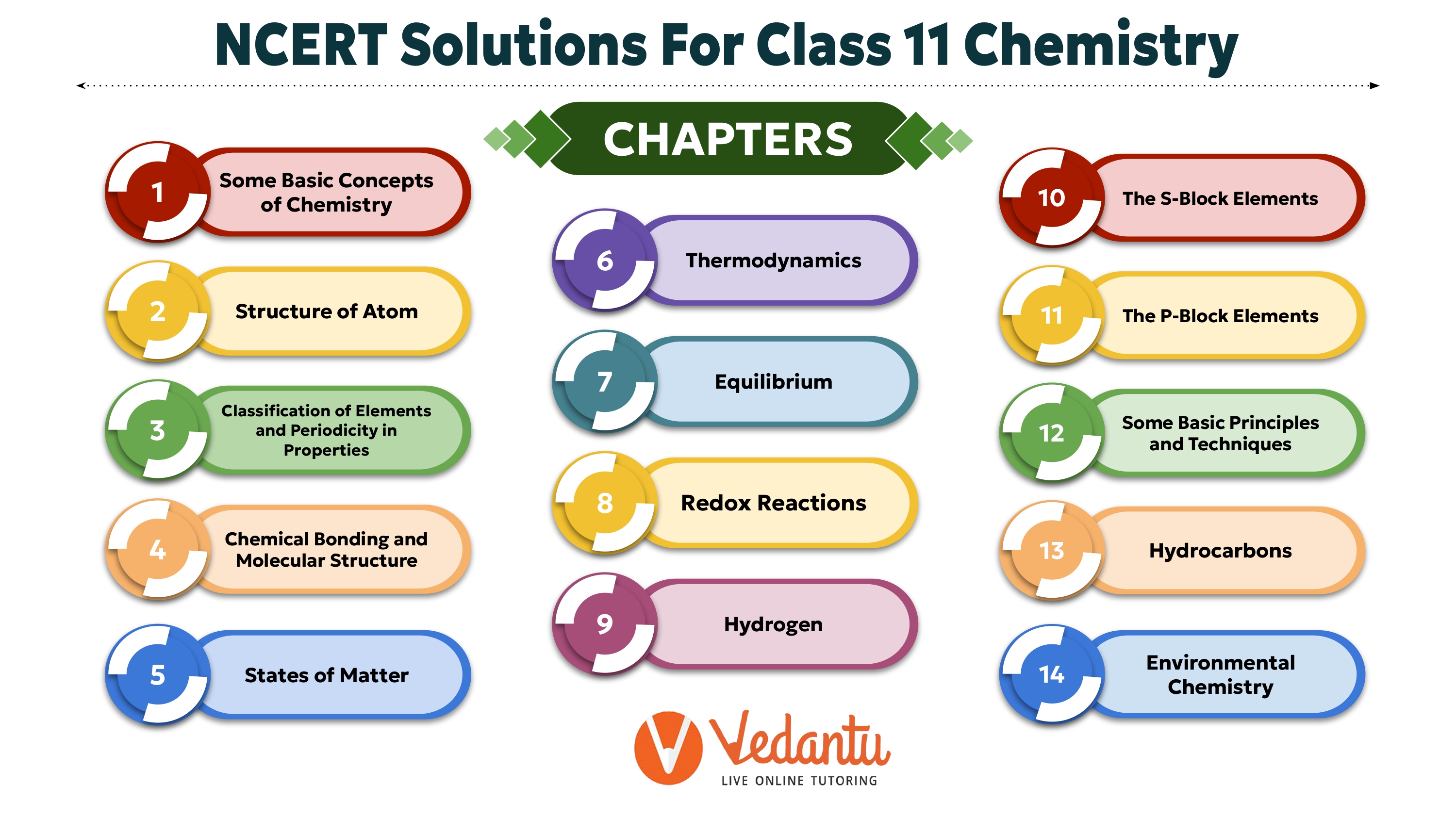Chapter-wise Class 11 Chemistry Questions and Answers Free PDF Download
FAQs on NCERT Solutions For Class 11 Chemistry All Chapters - 2025-26
1. What chapters are included in the NCERT Solutions for Class 11 Chemistry for the academic year 2025-26?
The NCERT Solutions for Class 11 Chemistry are based on the revised CBSE syllabus for 2025-26, covering the following 9 chapters:
- Chapter 1: Some Basic Concepts of Chemistry
- Chapter 2: Structure of Atom
- Chapter 3: Classification of Elements and Periodicity in Properties
- Chapter 4: Chemical Bonding and Molecular Structure
- Chapter 5: Chemical Thermodynamics
- Chapter 6: Equilibrium
- Chapter 7: Redox Reactions
- Chapter 8: Organic Chemistry – Some Basic Principles and Techniques
- Chapter 9: Hydrocarbons
2. How are the NCERT Solutions for Class 11 Chemistry divided between the Part 1 and Part 2 textbooks?
The NCERT Class 11 Chemistry syllabus is split into two textbooks. The solutions are structured accordingly:
- Part 1 Solutions: Typically cover the initial chapters focusing on Physical and Inorganic Chemistry, including topics like Atomic Structure, Chemical Bonding, and Thermodynamics.
- Part 2 Solutions: Focus on the remaining chapters, primarily dealing with Organic Chemistry (Basic Principles, Hydrocarbons) and other key topics from the syllabus.
3. What is the correct method for solving numericals from 'Some Basic Concepts of Chemistry' using the NCERT Solutions?
The solutions demonstrate the standard CBSE method for solving numericals, which involves a clear, step-by-step approach:
- Identify and list the given data with their correct units.
- State the relevant formula required to solve the problem (e.g., Molarity = Moles of solute / Volume of solution in L).
- Show the substitution of values into the formula.
- Perform the calculation clearly.
- Write the final answer with the correct units, ensuring it is highlighted.
Following this structured method helps in securing full marks in exams.
4. Why is it important to follow the detailed steps in the NCERT Solutions instead of just finding the final answer?
Following the step-by-step methodology shown in the NCERT Solutions is crucial for several reasons. Firstly, the CBSE evaluation pattern often awards marks for each correct step, not just the final answer. Secondly, this approach helps you understand the logical flow of the solution, making it easier to identify and correct your own mistakes. It builds a disciplined problem-solving habit, which is essential for tackling complex questions and reinforces conceptual clarity.
5. How do the NCERT Solutions explain complex concepts like VSEPR theory and hybridization in the 'Chemical Bonding' chapter?
The NCERT Solutions for 'Chemical Bonding and Molecular Structure' break down complex topics like VSEPR theory and hybridization by providing clear, systematic explanations for each textbook question. They show how to determine the geometry of molecules by identifying the number of lone pairs and bond pairs of electrons. For hybridization, the solutions correlate the type of hybridization (sp, sp², sp³) with the molecule's shape (linear, trigonal planar, tetrahedral) using specific examples from the NCERT textbook.
6. How do the solutions for Class 11 Organic Chemistry help in understanding IUPAC nomenclature and reaction mechanisms?
For Organic Chemistry chapters, the NCERT Solutions meticulously apply the IUPAC nomenclature rules to name complex compounds, explaining the logic behind selecting the parent chain and numbering substituents. When dealing with reaction mechanisms, such as electrophilic addition in alkenes, the solutions provide a step-by-step breakdown showing the movement of electrons and the formation of intermediates like carbocations, clarifying the entire process.
7. Beyond homework, how do Class 11 Chemistry NCERT Solutions prepare students for competitive exams like NEET or JEE?
While these solutions are tailored for the CBSE board, they build the fundamental conceptual base required for competitive exams. By mastering the problem-solving techniques for every question in the NCERT textbook, students develop a deep understanding of core principles in thermodynamics, equilibrium, and organic chemistry. This strong foundation is the first and most critical step before moving on to advanced, application-based problems found in NEET and JEE.
8. Which chapters were removed from the Class 11 Chemistry syllabus for 2025-26, and do the solutions cover them?
As per the latest CBSE guidelines, the following five chapters have been removed from the Class 11 Chemistry syllabus: States of Matter, Hydrogen, The s-Block Elements, The p-Block Elements, and Environmental Chemistry. The Vedantu NCERT Solutions for the 2025-26 academic year are updated accordingly and provide answers only for the 9 chapters currently in the syllabus, ensuring your preparation is focused and relevant.
9. What are common errors students make while solving Equilibrium questions, and how do the solutions help prevent them?
A common mistake in the 'Equilibrium' chapter is incorrectly writing the expression for the equilibrium constant (Kc), especially forgetting to exclude the concentrations of pure solids and liquids. Another frequent error is the misapplication of Le Chatelier's principle. The NCERT Solutions address this by demonstrating the correct way to set up equilibrium expressions and clearly explaining how changes in concentration, pressure, or temperature shift the equilibrium for specific reactions, thereby correcting these misconceptions.
10. How do the solutions clarify the difference between easily confused concepts like empirical and molecular formulas?
The NCERT solutions address confusing pairs of concepts by solving problems that directly highlight their differences. For example, when solving for empirical and molecular formulas, the solutions first guide you to calculate the simplest whole-number ratio of atoms (empirical formula) from percentage composition. Then, they show the distinct next step of using the molar mass to find the actual number of atoms in the molecule (molecular formula), thus clarifying the relationship between the two.


























